AMD Radeon HD 7970 GHz Edition Review: Battling For The Performance Crown
by Ryan Smith on June 22, 2012 12:01 AM EST- Posted in
- GPUs
- AMD
- GCN
- Radeon HD 7000
OC: Power, Temperature, & Noise
Our final task is our look at the 7970GE’s overclocking capabilities. As the 7970GE is based on the existing 7970 we aren’t expecting any significant changes, however it’s reasonable to expect that general manufacturing process improvements over the last 6 months will have pushed yields and tolerances a little higher, giving us just a bit more headroom.
At the same time the presence of the boost clock and its associated voltage is going to change overclocking as well. The higher voltage should lend itself to higher overclocks, meanwhile validating overclocks is also going to be a bit harder as now we need to make sure neither the overclocked base clock/voltage combination or the overclocked boost clock/voltage combination is unstable, similar to the extra effort needed to overclock the GTX 680 series.
| Radeon HD 7970 Series Overclocking | |||||
| Ref 7970GE | Ref 7970 | XFX 7970 BEDD | |||
| Shipping Core Clock | 1000MHz | 925MHz | 1000MHz | ||
| Shipping Max Boost Clock | 1050MHz | N/A | N/A | ||
| Shipping Memory Clock | 6GHz | 5.5GHz | 5.7GHz | ||
| Shipping Max Voltage | 1.218v | 1.175v | 1.175v | ||
| Overclock Core Clock | 1150MHz | 1100MHz | 1125MHz | ||
| Overclock Max Boost Clock | 1200MHz | N/A | N/A | ||
| Overclock Memory Clock | 6.4GHz | 6.3GHz | 6.3GHz | ||
| Overclock Max Boost Voltage | 1.218v | 1.175v | 1.175v | ||
After going through the full validation process we were able to hit an overclock of +150MHz, which pushed our base clock from 1000MHz to 1150MHz, and our boost clock from 1050MHz to 1200MHz. Depending on how you want to count this overclock amidst the presence of the boost clock this is either 25MHz better than our best 7970 card, or 75MHz better. In either case our 7970GE definitely overclocks better than our earlier 7970 cards but not significantly so, which is in-line with our expectations.
As with any overclocking effort based on a single sample our overclocking results are not going to be representative of what every card can do, but they are reasonable. With AMD now binning chips for the 7970GE we’d expect to see some stratification among the 7970 family such that high overclocking chips that would previously show up in 7970 cards will now show up in 7970GE cards instead. For penny-pinching overclockers this is not good news, but for more hardcore overclockers this is nothing new as AMD’s partners have been doing something similar with their factory overclocked cards for some time now.
Meanwhile our memory overclock isn’t significantly different from what we could pull off with the reference 7970. The limitation is the memory bus or Tahiti’s memory controller, neither of which has changed. After around 6.4GHz errors start catching up and performance gains become performance losses.
Moving on to our performance charts, we’re going to once again start with power, temperature, and noise, before moving on to gaming performance. We’ll be testing our 7970 cards with the PowerTune limit set to +20% in order to avoid any real possibility of being performance limited by PowerTune.
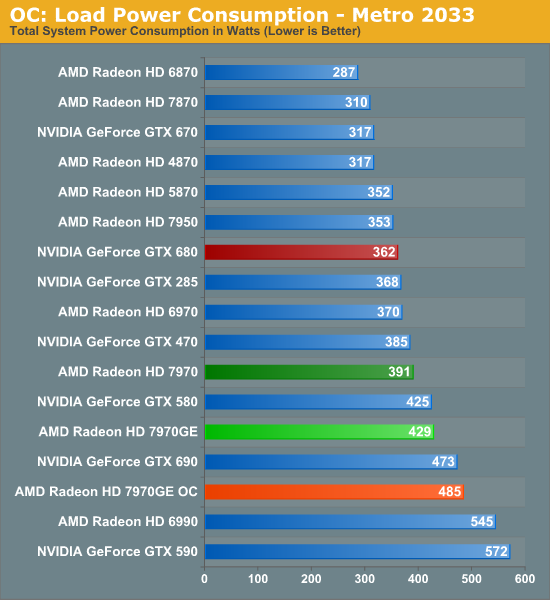
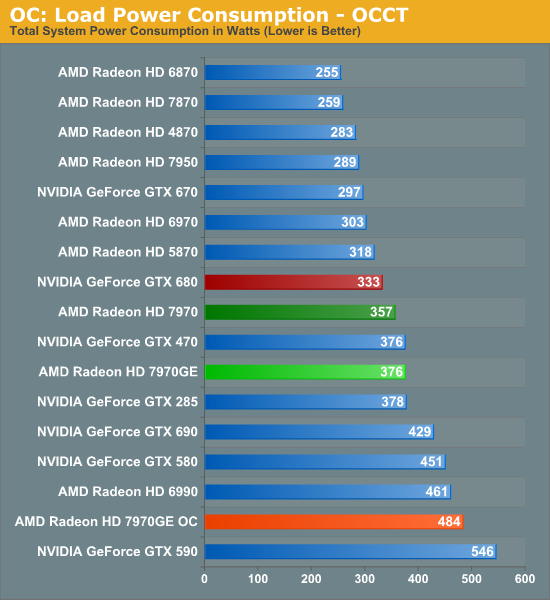
With the 7970GE’s already high load power, overclocking and raising the PowerTune limits isn’t doing it any favors when it comes to overclocking. On the contrary to being a free overclock power consumption now exceeds even the GTX 690 in all situations and power consumption is almost certainly in excess of 300W at the card level. As we’ll see in our gaming performance section we’re definitely getting more performance out of the 7970GE, but we’re paying for it with power.
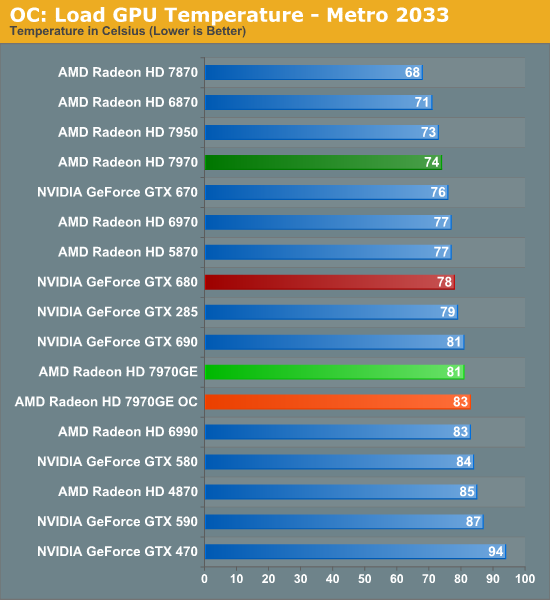
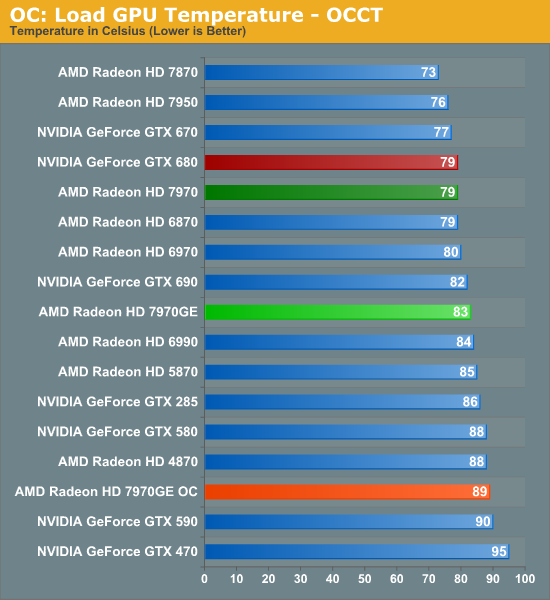
With a rise in power consumption comes a rise in temperatures to a varying degree. At 83C under Metro the 7970GE has gotten warmer, but not significantly so. The same cannot be said for OCCT. At 89C we’re approaching the reasonable limits for this card and cooler.

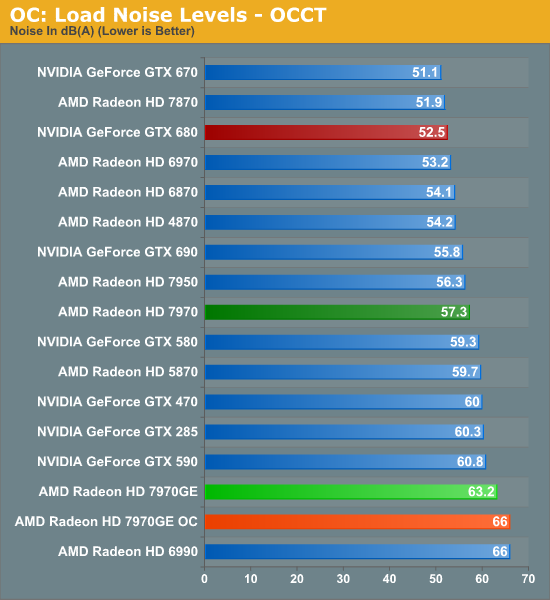
The 7970GE was already loud at stock and overclocking it doesn’t help. Under Metro noise is now at 63.8dBA, and under OCCT it’s tied with the 6990 for noise at 66dBA. Even if you’re forgiving of noise, this is reaching the point where it’s going to be difficult to ignore. Serious 7970GE overclockers will want to seek other cards and/or aftermarket coolers.










110 Comments
View All Comments
Ammaross - Friday, June 22, 2012 - link
So, since the 7970 GE is essentially a tweaked OCed 7970, why not include a factory-overclocked nVidia 680 for fairness? There's a whole lot of headroom on those 680s as well that these benches leave untouched and unrepresented.elitistlinuxuser - Friday, June 22, 2012 - link
Can it run pong and at what frame ratesRumpelstiltstein - Friday, June 22, 2012 - link
Why is Nvidia red and AMD Green?Galcobar - Friday, June 22, 2012 - link
Standard graph colouring on Anandtech is that the current product is highlighted in green, specific comparison products in red. The graphs on page 3 for driver updates aren't a standard graph for video card reviews.Also, typo noted on page 18 (OC Gaming Performance), the paragraph under the Portal 2 1920 chart: "With Portal 2 being one of the 7970GE’s biggest defEcits" -- deficits
mikezachlowe2004 - Sunday, June 24, 2012 - link
Computer performance is a big factor in deciding in purchase as well and I am disappointed to not see any mention of this in the conclusion. AMD blows nVidia out the water when it comes to compute performance and this should not be taken lightly seeing as games right now are implementing more and more compute capabilities in games and many other things. Compute performance has been growing and growing and today at a rate higher than ever and it is very disappointing to see no mention of this in Anand's conclusion.I use autoCAD for work all the time but I also enjoy playing games as well and with a workload like this, AMDs GPU provide a huge advantage over nVidia simply because nVidias GK104 compute performance is no where near that of AMDs. AMD is the obvious choice for someone like me.
As far as the noise and temps go, I personally feel if your spending $500 on a GPU and obviously thousands on your system there is no reason not tospend a couple hundred on water cooling. Water cooling completely eliminates any concern for temps and noise which should make AMDs card the clear choice. Same goes for power consumption. If you're spending thousands on a system there is no reason you should be worried about a couple extra dollars a month on your bill. This is just how I see it. Now don't get me wrong, nVidia has a great card for gaming, but gaming only. AMD offers the best of both worlds. Both gaming and compute and to me, this makes the 7000 series the clear winner to me.
CeriseCogburn - Sunday, June 24, 2012 - link
It might help if you had a clue concerning what you're talking about." CAD Autodesk with plug-ins are exclusive on Cuda cores Nvidia cards. Going crossfire 7970 will not change that from 5850. Better off go for GTX580."
" The RADEON HD 7000 series will work with Autodesk Autocad and Revitt applications. However, we recommend using the Firepro card as it has full support for the applications you are using as it has the certified drivers. For the list of compatible certified video cards, please visit http://support.amd.com/us/gpudownload/fire/certifi... "
nVidia works out of the box, amd does NOT - you must spend thousands on Firepro.
Welcome to reality, the real one that amd fanboys never travel in.
spdrcrtob - Tuesday, July 17, 2012 - link
It might help if you knew what you are talking about...CAD as infer is AutoCAD by Autodesk and it doesn't have any CUDA dedicated plugin's. You are thinking of 3DS Max's method of Rendering called iRay. That's even fairly new from 2011 release.
There's isn't anything else that uses CUDA processors on a dedicated scale unless its a 3rd Party program or plugin. But not in AutoCAD, AutoCAD barely needs anything. So get it straight.
R-E-V-I-T ( with one T) requires more as there's rendering engine built in not to mention its mostly worked in as a 3D application, unlike AutoCAD which is mostly used in 2D.
Going Crossover won't help because most mid-range and high end single GPU's (AMD & NVIDIA) will be fine for ANY surface modeling and/ or 3D Rendering. If you use the application right you can increase performance numbers instead of increasing card count.
All Autodesk products work with any GPU really, there are supported or "certified" drivers and cards, usually only "CAD" cards like Fire Pro or Quadro's.
Nvidia's and AMD's work right out of the Box, just depends on the Add In Board partner and build quality NVIDIA fan boy. If you're going to state facts , then get your facts straight where it matters. Not your self thought cute remarks.
Do more research or don't state something you know nothing about. I have supported CAD and Engineering Environments and the applications they use for 8yrs now, before that 5 yrs more of IT support experience.
aranilah - Monday, June 25, 2012 - link
please put up a graph of the 680 overclocked to its maximum potential versus this to its maximum oc, that would be a different story i believe , not sure though. Please do it because on you 680 review there is no OC testing :/MrSpadge - Monday, June 25, 2012 - link
- AMDs boost assumes the stock heatsink - how is this affected by custom / 3rd party heat sinks? Will the chip think it's melting, whereas in reality it's crusing along just fine?- A simple fix would be to read out the actual temperature diode(s) already present within the chip. Sure, not deterministic.. but AMD could let users switch to this mode for better accuracy.
- AMD could implement a calibration routine into the control panel to adjust the digital temperature estimation to the atcual heat sink present -> this might avoid the problem altogether.
- Overvolting just to reach 1.05 GHz? I don't think this is necessary. Actually, I think AMD is generously overvolting most CPUs and some GPUs in the recent years. Some calibration for the actual chip capability would be nice as well - i.e. test if MY GPU really needs more voltage to reach the boost clock.
- 4 digit product numbers and only fully using 2 of them, plus the 3rd one to a limited extend (only 2 states to distinguish - 5 and 7). This is ridiculous! The numbers are there to indicate performance!!!
- Bring out cheaper 1.5 GB versions for us number crunchers.
- Bring an HD7960 with approx. the same amount of shaders as the HD7950, but ~1 GHz clock speeds. Most chips should easily do this.. and AMD could sell the same chip for more, since it would be faster.
Hrel - Monday, June 25, 2012 - link
How can you write a review like this, specifically to test one card against another, then only overclock one of them in the "OC gaming performance" section. Push the GTX680 as far as you can too otherwise those results are completely meaningless; for comparison.